Article Analysis: Leadership Roles for Women in Education Settings
VerifiedAdded on 2022/10/04
|6
|1766
|241
Report
AI Summary
This report provides an analysis of an article comparing women leaders in higher education institutions in Britain and Germany. The article highlights the underrepresentation of women in senior academic positions and explores the gendered perceptions of leadership characteristics. It discusses the historical and present-day challenges women face, including gender biases in leadership programs and the societal expectations of leadership styles. The analysis examines the article's findings, which suggest that gender plays a role in leadership selection and that women should be allowed to challenge academic cultural practices. The report also presents possible solutions, such as promoting equality from the beginning, mitigating gender-based differentiation, and appointing a higher number of women leaders. The author reflects on personal experiences related to gender bias in the workplace and emphasizes the article's contribution to highlighting gender bias in academic institutions. The report references relevant literature and offers insights into the complexities of gender equality in leadership.
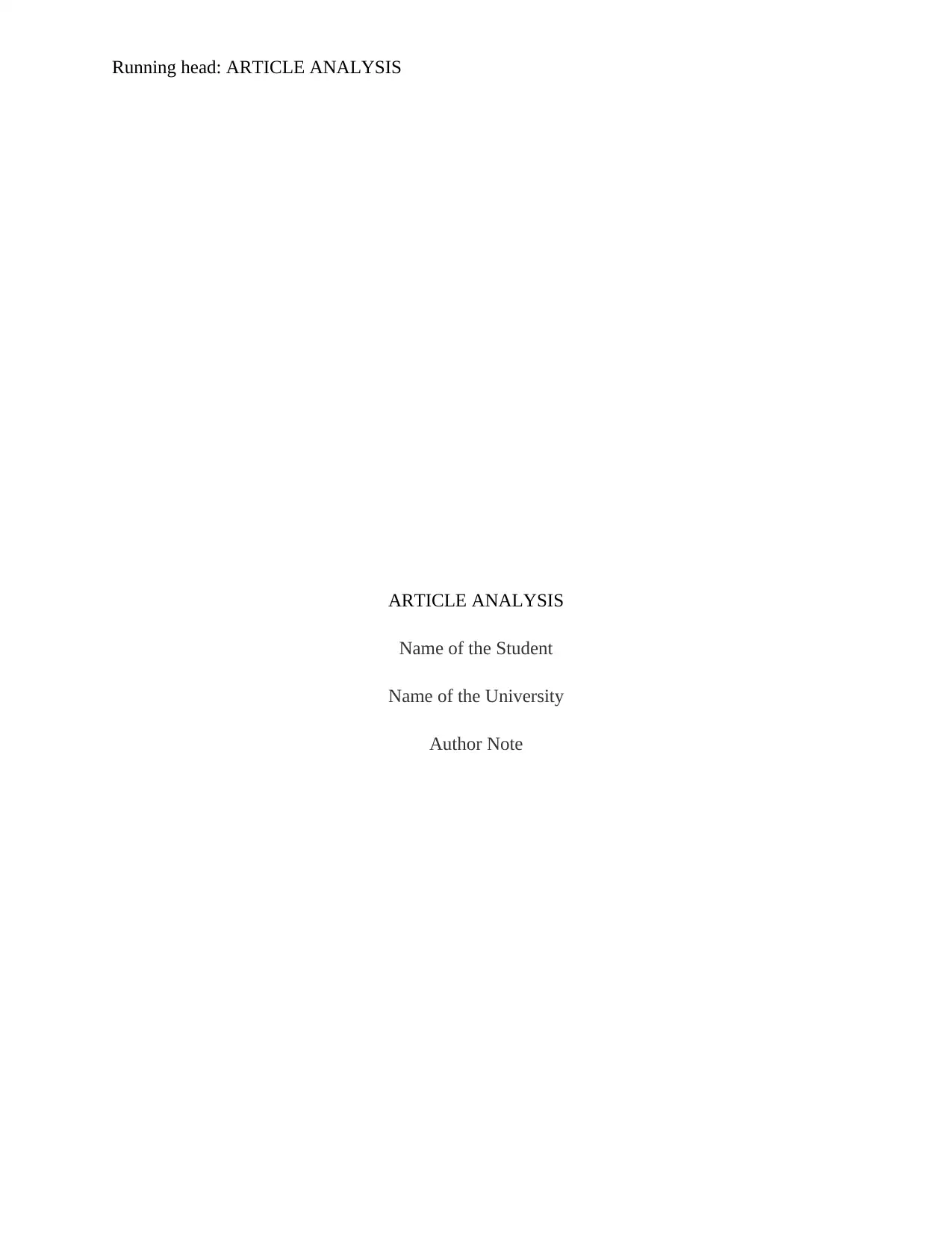
Running head: ARTICLE ANALYSIS
ARTICLE ANALYSIS
Name of the Student
Name of the University
Author Note
ARTICLE ANALYSIS
Name of the Student
Name of the University
Author Note
Paraphrase This Document
Need a fresh take? Get an instant paraphrase of this document with our AI Paraphraser
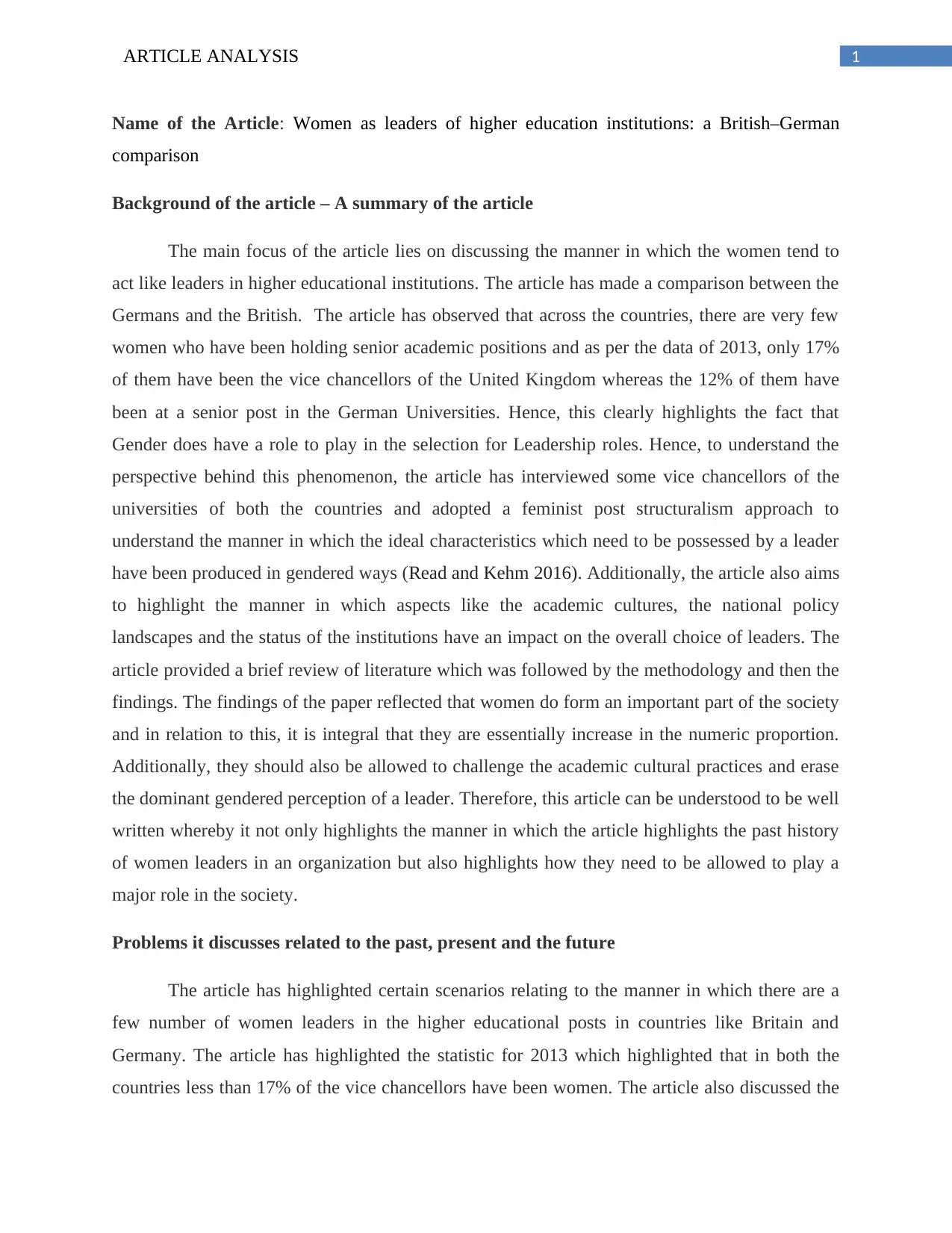
1ARTICLE ANALYSIS
Name of the Article: Women as leaders of higher education institutions: a British–German
comparison
Background of the article – A summary of the article
The main focus of the article lies on discussing the manner in which the women tend to
act like leaders in higher educational institutions. The article has made a comparison between the
Germans and the British. The article has observed that across the countries, there are very few
women who have been holding senior academic positions and as per the data of 2013, only 17%
of them have been the vice chancellors of the United Kingdom whereas the 12% of them have
been at a senior post in the German Universities. Hence, this clearly highlights the fact that
Gender does have a role to play in the selection for Leadership roles. Hence, to understand the
perspective behind this phenomenon, the article has interviewed some vice chancellors of the
universities of both the countries and adopted a feminist post structuralism approach to
understand the manner in which the ideal characteristics which need to be possessed by a leader
have been produced in gendered ways (Read and Kehm 2016). Additionally, the article also aims
to highlight the manner in which aspects like the academic cultures, the national policy
landscapes and the status of the institutions have an impact on the overall choice of leaders. The
article provided a brief review of literature which was followed by the methodology and then the
findings. The findings of the paper reflected that women do form an important part of the society
and in relation to this, it is integral that they are essentially increase in the numeric proportion.
Additionally, they should also be allowed to challenge the academic cultural practices and erase
the dominant gendered perception of a leader. Therefore, this article can be understood to be well
written whereby it not only highlights the manner in which the article highlights the past history
of women leaders in an organization but also highlights how they need to be allowed to play a
major role in the society.
Problems it discusses related to the past, present and the future
The article has highlighted certain scenarios relating to the manner in which there are a
few number of women leaders in the higher educational posts in countries like Britain and
Germany. The article has highlighted the statistic for 2013 which highlighted that in both the
countries less than 17% of the vice chancellors have been women. The article also discussed the
Name of the Article: Women as leaders of higher education institutions: a British–German
comparison
Background of the article – A summary of the article
The main focus of the article lies on discussing the manner in which the women tend to
act like leaders in higher educational institutions. The article has made a comparison between the
Germans and the British. The article has observed that across the countries, there are very few
women who have been holding senior academic positions and as per the data of 2013, only 17%
of them have been the vice chancellors of the United Kingdom whereas the 12% of them have
been at a senior post in the German Universities. Hence, this clearly highlights the fact that
Gender does have a role to play in the selection for Leadership roles. Hence, to understand the
perspective behind this phenomenon, the article has interviewed some vice chancellors of the
universities of both the countries and adopted a feminist post structuralism approach to
understand the manner in which the ideal characteristics which need to be possessed by a leader
have been produced in gendered ways (Read and Kehm 2016). Additionally, the article also aims
to highlight the manner in which aspects like the academic cultures, the national policy
landscapes and the status of the institutions have an impact on the overall choice of leaders. The
article provided a brief review of literature which was followed by the methodology and then the
findings. The findings of the paper reflected that women do form an important part of the society
and in relation to this, it is integral that they are essentially increase in the numeric proportion.
Additionally, they should also be allowed to challenge the academic cultural practices and erase
the dominant gendered perception of a leader. Therefore, this article can be understood to be well
written whereby it not only highlights the manner in which the article highlights the past history
of women leaders in an organization but also highlights how they need to be allowed to play a
major role in the society.
Problems it discusses related to the past, present and the future
The article has highlighted certain scenarios relating to the manner in which there are a
few number of women leaders in the higher educational posts in countries like Britain and
Germany. The article has highlighted the statistic for 2013 which highlighted that in both the
countries less than 17% of the vice chancellors have been women. The article also discussed the
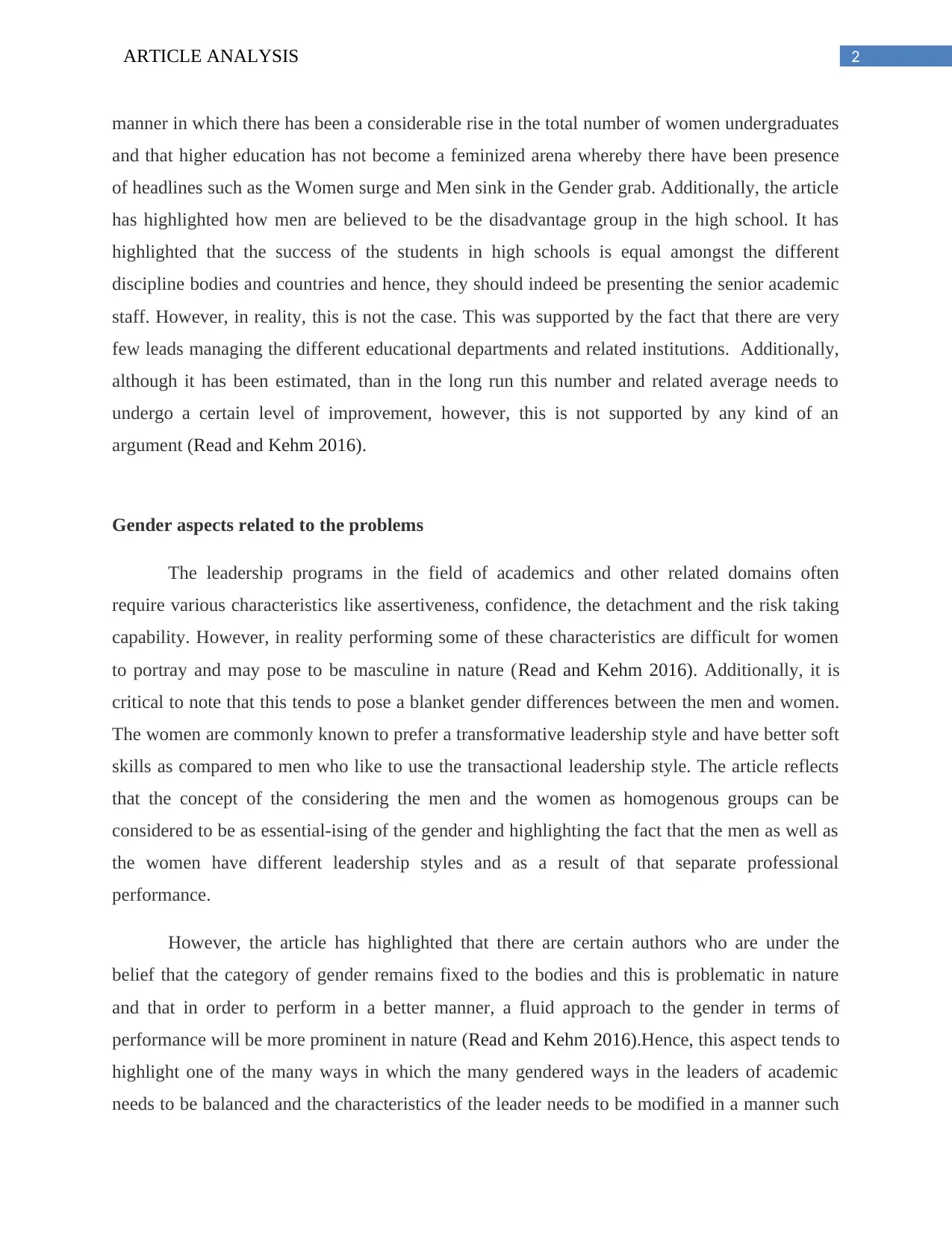
2ARTICLE ANALYSIS
manner in which there has been a considerable rise in the total number of women undergraduates
and that higher education has not become a feminized arena whereby there have been presence
of headlines such as the Women surge and Men sink in the Gender grab. Additionally, the article
has highlighted how men are believed to be the disadvantage group in the high school. It has
highlighted that the success of the students in high schools is equal amongst the different
discipline bodies and countries and hence, they should indeed be presenting the senior academic
staff. However, in reality, this is not the case. This was supported by the fact that there are very
few leads managing the different educational departments and related institutions. Additionally,
although it has been estimated, than in the long run this number and related average needs to
undergo a certain level of improvement, however, this is not supported by any kind of an
argument (Read and Kehm 2016).
Gender aspects related to the problems
The leadership programs in the field of academics and other related domains often
require various characteristics like assertiveness, confidence, the detachment and the risk taking
capability. However, in reality performing some of these characteristics are difficult for women
to portray and may pose to be masculine in nature (Read and Kehm 2016). Additionally, it is
critical to note that this tends to pose a blanket gender differences between the men and women.
The women are commonly known to prefer a transformative leadership style and have better soft
skills as compared to men who like to use the transactional leadership style. The article reflects
that the concept of the considering the men and the women as homogenous groups can be
considered to be as essential-ising of the gender and highlighting the fact that the men as well as
the women have different leadership styles and as a result of that separate professional
performance.
However, the article has highlighted that there are certain authors who are under the
belief that the category of gender remains fixed to the bodies and this is problematic in nature
and that in order to perform in a better manner, a fluid approach to the gender in terms of
performance will be more prominent in nature (Read and Kehm 2016).Hence, this aspect tends to
highlight one of the many ways in which the many gendered ways in the leaders of academic
needs to be balanced and the characteristics of the leader needs to be modified in a manner such
manner in which there has been a considerable rise in the total number of women undergraduates
and that higher education has not become a feminized arena whereby there have been presence
of headlines such as the Women surge and Men sink in the Gender grab. Additionally, the article
has highlighted how men are believed to be the disadvantage group in the high school. It has
highlighted that the success of the students in high schools is equal amongst the different
discipline bodies and countries and hence, they should indeed be presenting the senior academic
staff. However, in reality, this is not the case. This was supported by the fact that there are very
few leads managing the different educational departments and related institutions. Additionally,
although it has been estimated, than in the long run this number and related average needs to
undergo a certain level of improvement, however, this is not supported by any kind of an
argument (Read and Kehm 2016).
Gender aspects related to the problems
The leadership programs in the field of academics and other related domains often
require various characteristics like assertiveness, confidence, the detachment and the risk taking
capability. However, in reality performing some of these characteristics are difficult for women
to portray and may pose to be masculine in nature (Read and Kehm 2016). Additionally, it is
critical to note that this tends to pose a blanket gender differences between the men and women.
The women are commonly known to prefer a transformative leadership style and have better soft
skills as compared to men who like to use the transactional leadership style. The article reflects
that the concept of the considering the men and the women as homogenous groups can be
considered to be as essential-ising of the gender and highlighting the fact that the men as well as
the women have different leadership styles and as a result of that separate professional
performance.
However, the article has highlighted that there are certain authors who are under the
belief that the category of gender remains fixed to the bodies and this is problematic in nature
and that in order to perform in a better manner, a fluid approach to the gender in terms of
performance will be more prominent in nature (Read and Kehm 2016).Hence, this aspect tends to
highlight one of the many ways in which the many gendered ways in the leaders of academic
needs to be balanced and the characteristics of the leader needs to be modified in a manner such
⊘ This is a preview!⊘
Do you want full access?
Subscribe today to unlock all pages.

Trusted by 1+ million students worldwide
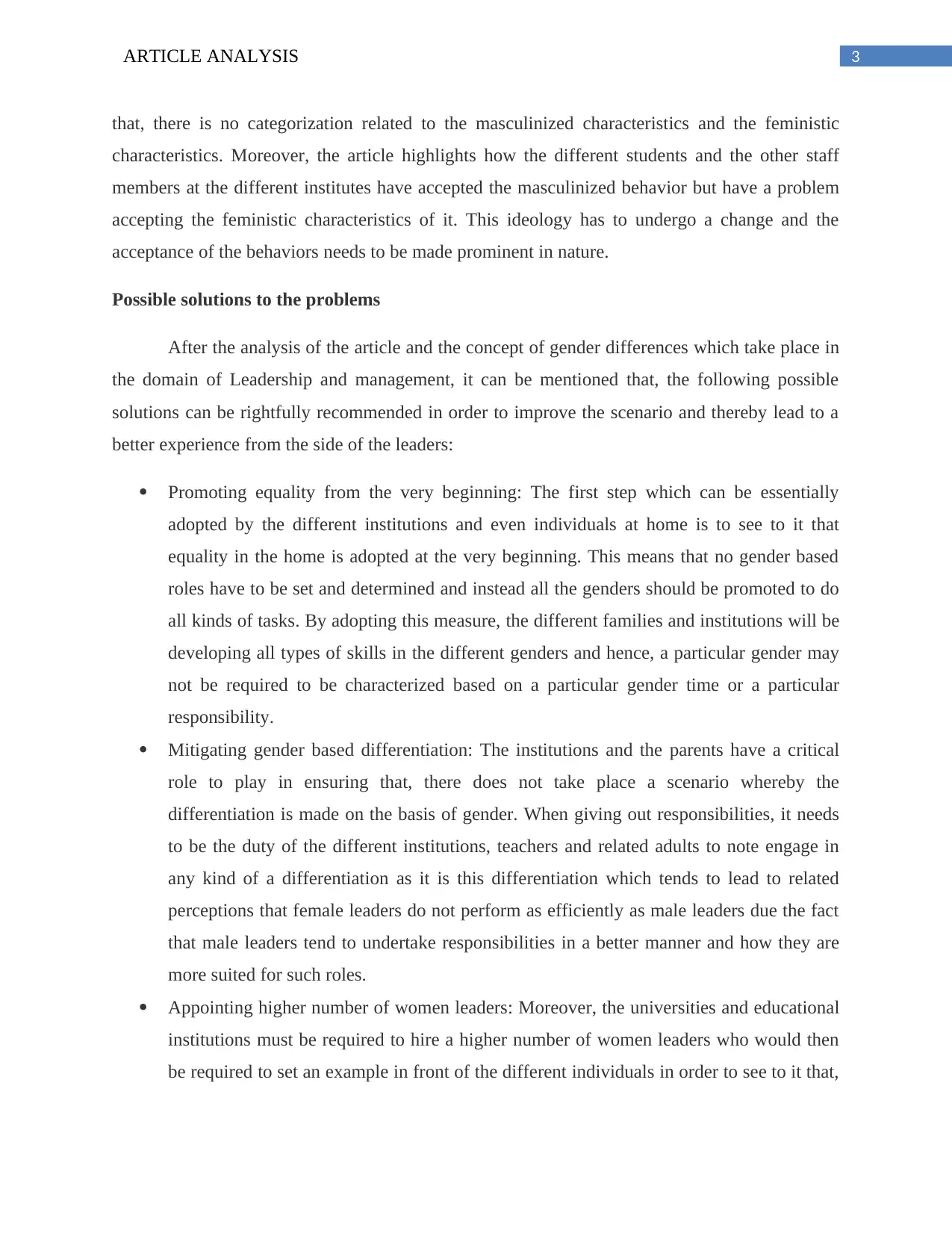
3ARTICLE ANALYSIS
that, there is no categorization related to the masculinized characteristics and the feministic
characteristics. Moreover, the article highlights how the different students and the other staff
members at the different institutes have accepted the masculinized behavior but have a problem
accepting the feministic characteristics of it. This ideology has to undergo a change and the
acceptance of the behaviors needs to be made prominent in nature.
Possible solutions to the problems
After the analysis of the article and the concept of gender differences which take place in
the domain of Leadership and management, it can be mentioned that, the following possible
solutions can be rightfully recommended in order to improve the scenario and thereby lead to a
better experience from the side of the leaders:
Promoting equality from the very beginning: The first step which can be essentially
adopted by the different institutions and even individuals at home is to see to it that
equality in the home is adopted at the very beginning. This means that no gender based
roles have to be set and determined and instead all the genders should be promoted to do
all kinds of tasks. By adopting this measure, the different families and institutions will be
developing all types of skills in the different genders and hence, a particular gender may
not be required to be characterized based on a particular gender time or a particular
responsibility.
Mitigating gender based differentiation: The institutions and the parents have a critical
role to play in ensuring that, there does not take place a scenario whereby the
differentiation is made on the basis of gender. When giving out responsibilities, it needs
to be the duty of the different institutions, teachers and related adults to note engage in
any kind of a differentiation as it is this differentiation which tends to lead to related
perceptions that female leaders do not perform as efficiently as male leaders due the fact
that male leaders tend to undertake responsibilities in a better manner and how they are
more suited for such roles.
Appointing higher number of women leaders: Moreover, the universities and educational
institutions must be required to hire a higher number of women leaders who would then
be required to set an example in front of the different individuals in order to see to it that,
that, there is no categorization related to the masculinized characteristics and the feministic
characteristics. Moreover, the article highlights how the different students and the other staff
members at the different institutes have accepted the masculinized behavior but have a problem
accepting the feministic characteristics of it. This ideology has to undergo a change and the
acceptance of the behaviors needs to be made prominent in nature.
Possible solutions to the problems
After the analysis of the article and the concept of gender differences which take place in
the domain of Leadership and management, it can be mentioned that, the following possible
solutions can be rightfully recommended in order to improve the scenario and thereby lead to a
better experience from the side of the leaders:
Promoting equality from the very beginning: The first step which can be essentially
adopted by the different institutions and even individuals at home is to see to it that
equality in the home is adopted at the very beginning. This means that no gender based
roles have to be set and determined and instead all the genders should be promoted to do
all kinds of tasks. By adopting this measure, the different families and institutions will be
developing all types of skills in the different genders and hence, a particular gender may
not be required to be characterized based on a particular gender time or a particular
responsibility.
Mitigating gender based differentiation: The institutions and the parents have a critical
role to play in ensuring that, there does not take place a scenario whereby the
differentiation is made on the basis of gender. When giving out responsibilities, it needs
to be the duty of the different institutions, teachers and related adults to note engage in
any kind of a differentiation as it is this differentiation which tends to lead to related
perceptions that female leaders do not perform as efficiently as male leaders due the fact
that male leaders tend to undertake responsibilities in a better manner and how they are
more suited for such roles.
Appointing higher number of women leaders: Moreover, the universities and educational
institutions must be required to hire a higher number of women leaders who would then
be required to set an example in front of the different individuals in order to see to it that,
Paraphrase This Document
Need a fresh take? Get an instant paraphrase of this document with our AI Paraphraser
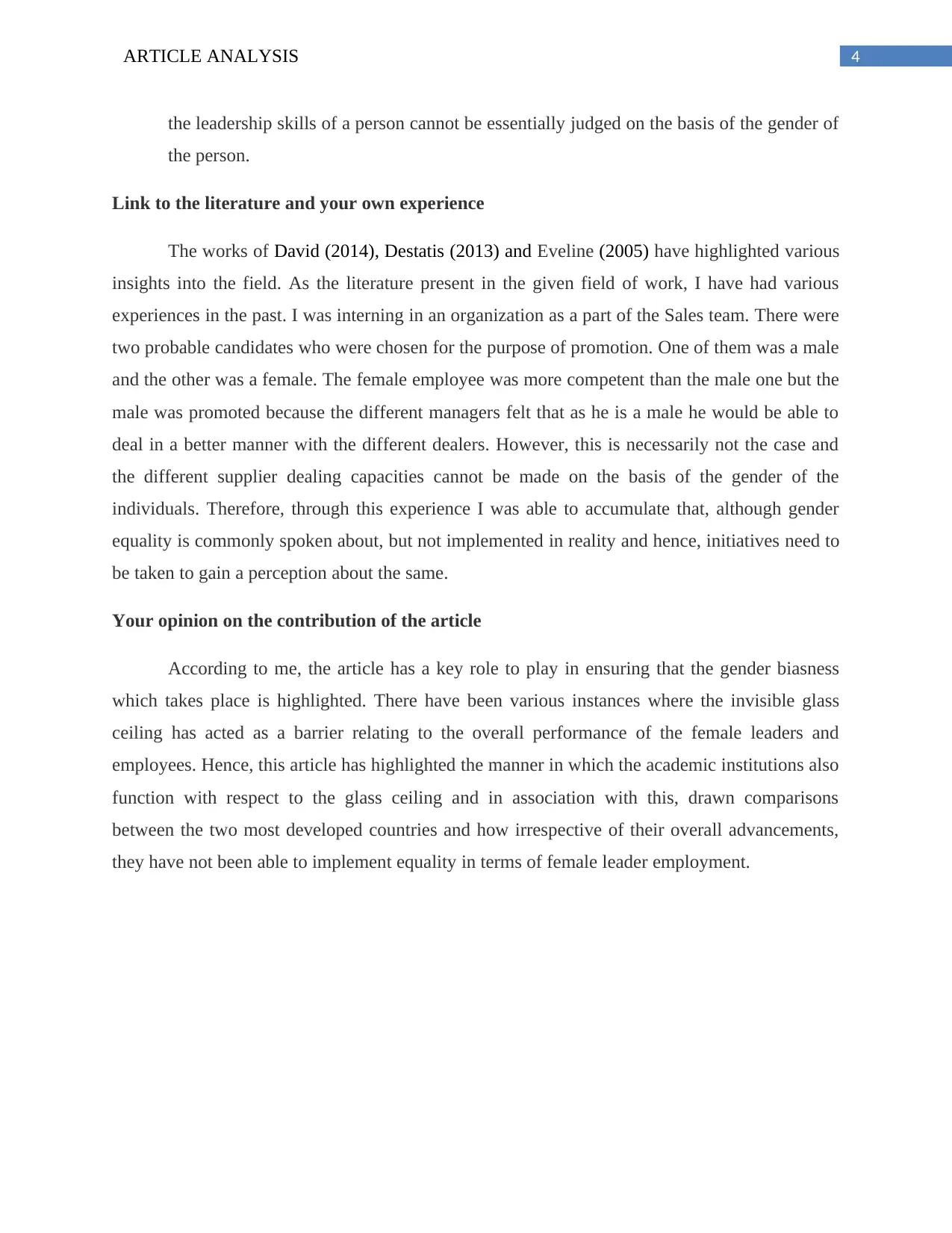
4ARTICLE ANALYSIS
the leadership skills of a person cannot be essentially judged on the basis of the gender of
the person.
Link to the literature and your own experience
The works of David (2014), Destatis (2013) and Eveline (2005) have highlighted various
insights into the field. As the literature present in the given field of work, I have had various
experiences in the past. I was interning in an organization as a part of the Sales team. There were
two probable candidates who were chosen for the purpose of promotion. One of them was a male
and the other was a female. The female employee was more competent than the male one but the
male was promoted because the different managers felt that as he is a male he would be able to
deal in a better manner with the different dealers. However, this is necessarily not the case and
the different supplier dealing capacities cannot be made on the basis of the gender of the
individuals. Therefore, through this experience I was able to accumulate that, although gender
equality is commonly spoken about, but not implemented in reality and hence, initiatives need to
be taken to gain a perception about the same.
Your opinion on the contribution of the article
According to me, the article has a key role to play in ensuring that the gender biasness
which takes place is highlighted. There have been various instances where the invisible glass
ceiling has acted as a barrier relating to the overall performance of the female leaders and
employees. Hence, this article has highlighted the manner in which the academic institutions also
function with respect to the glass ceiling and in association with this, drawn comparisons
between the two most developed countries and how irrespective of their overall advancements,
they have not been able to implement equality in terms of female leader employment.
the leadership skills of a person cannot be essentially judged on the basis of the gender of
the person.
Link to the literature and your own experience
The works of David (2014), Destatis (2013) and Eveline (2005) have highlighted various
insights into the field. As the literature present in the given field of work, I have had various
experiences in the past. I was interning in an organization as a part of the Sales team. There were
two probable candidates who were chosen for the purpose of promotion. One of them was a male
and the other was a female. The female employee was more competent than the male one but the
male was promoted because the different managers felt that as he is a male he would be able to
deal in a better manner with the different dealers. However, this is necessarily not the case and
the different supplier dealing capacities cannot be made on the basis of the gender of the
individuals. Therefore, through this experience I was able to accumulate that, although gender
equality is commonly spoken about, but not implemented in reality and hence, initiatives need to
be taken to gain a perception about the same.
Your opinion on the contribution of the article
According to me, the article has a key role to play in ensuring that the gender biasness
which takes place is highlighted. There have been various instances where the invisible glass
ceiling has acted as a barrier relating to the overall performance of the female leaders and
employees. Hence, this article has highlighted the manner in which the academic institutions also
function with respect to the glass ceiling and in association with this, drawn comparisons
between the two most developed countries and how irrespective of their overall advancements,
they have not been able to implement equality in terms of female leader employment.
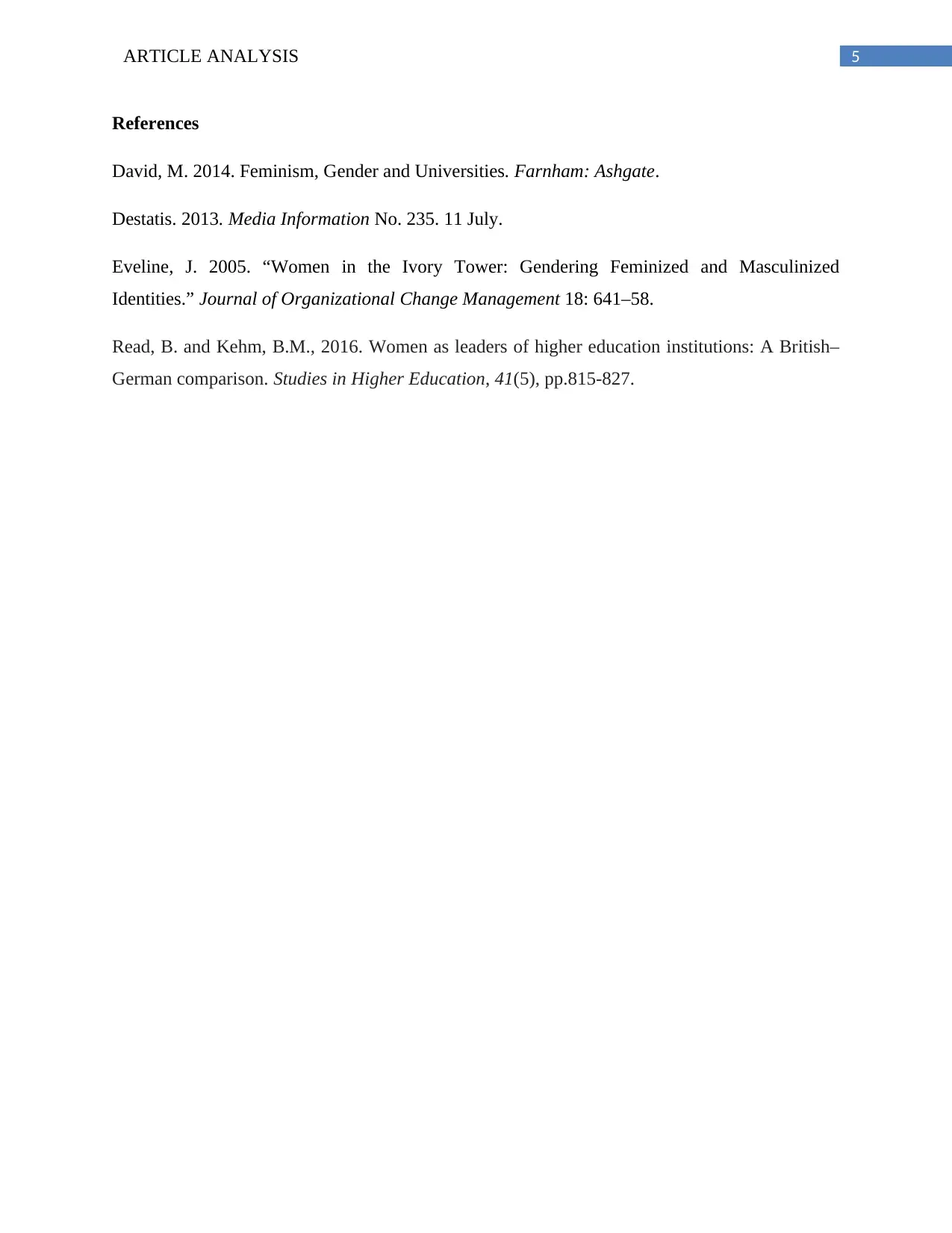
5ARTICLE ANALYSIS
References
David, M. 2014. Feminism, Gender and Universities. Farnham: Ashgate.
Destatis. 2013. Media Information No. 235. 11 July.
Eveline, J. 2005. “Women in the Ivory Tower: Gendering Feminized and Masculinized
Identities.” Journal of Organizational Change Management 18: 641–58.
Read, B. and Kehm, B.M., 2016. Women as leaders of higher education institutions: A British–
German comparison. Studies in Higher Education, 41(5), pp.815-827.
References
David, M. 2014. Feminism, Gender and Universities. Farnham: Ashgate.
Destatis. 2013. Media Information No. 235. 11 July.
Eveline, J. 2005. “Women in the Ivory Tower: Gendering Feminized and Masculinized
Identities.” Journal of Organizational Change Management 18: 641–58.
Read, B. and Kehm, B.M., 2016. Women as leaders of higher education institutions: A British–
German comparison. Studies in Higher Education, 41(5), pp.815-827.
⊘ This is a preview!⊘
Do you want full access?
Subscribe today to unlock all pages.

Trusted by 1+ million students worldwide
1 out of 6
Related Documents
Your All-in-One AI-Powered Toolkit for Academic Success.
+13062052269
info@desklib.com
Available 24*7 on WhatsApp / Email
![[object Object]](/_next/static/media/star-bottom.7253800d.svg)
Unlock your academic potential
Copyright © 2020–2025 A2Z Services. All Rights Reserved. Developed and managed by ZUCOL.





